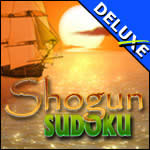- Wondering how to get Monopoly GO! free rolls? Well, you’ve come to the right place. In this guide, we provide you with a bunch of tips and tricks to get some free rolls for the hit new mobile game. We’ll …
Best Roblox Horror Games to Play Right Now – Updated Weekly
By Adele Wilson
Our Best Roblox Horror Games guide features the scariest and most creative experiences to play right now on the platform!The BEST Roblox Games of The Week – Games You Need To Play!
By Sho Roberts
Our feature shares our pick for the Best Roblox Games of the week! With our feature, we guarantee you'll find something new to play!All Grades in Type Soul – Each Race Explained
By Adele Wilson
Our All Grades in Type Soul guide lists every grade in the game for all races, including how to increase your grade quickly!
Shogun Sudoku Deluxe Review
Its been said the first 15 minutes of a game is the most critical – after all, we all know how important first impressions can be.
While Shogun Sudoku Deluxe is an entertaining and challenging puzzle game, it doesn’t follow the aforementioned rule. In fact, the first few minutes are rather bland and predictable. Thankfully, it’s not indicative of the entire game.
The core game-play surrounds Sudoku (pronounced “su-doe-ku”), the wildly popular number-based brainteasers found in many of the nation’s top newspapers, as well as in Sudoku books and video games.

Its been said the first 15 minutes of a game is the most critical – after all, we all know how important first impressions can be.
While Shogun Sudoku Deluxe is an entertaining and challenging puzzle game, it doesn’t follow the aforementioned rule. In fact, the first few minutes are rather bland and predictable. Thankfully, it’s not indicative of the entire game.
The core game-play surrounds Sudoku (pronounced “su-doe-ku”), the wildly popular number-based brainteasers found in many of the nation’s top newspapers, as well as in Sudoku books and video games.
You know the drill — fill all the blank squares on a 9×9 grid with the correct numbers – and the catch is that each row and column must contain numbers 1 though 9, with no repeats. What’s more, the nine 3×3 boxes that make up the grid must also contain numbers 1 through 9. Sudoku puzzles start with some numbers in the grid so you can begin the deduction process to fill in the rest. In many of the PC-based Sudoku games, if you’re unsure which number goes into a specific box you can right-mouse click to place a small “penciled” number as a temporary note.
At first, Shogun Sudoku Deluxe looks like every other Sudoku puzzle game in cyberspace, except that in the main Voyage of Discovery mode, you’re traveling across a world map and visiting one city after another – such as Paris, Casablanca and London — with slightly different graphics and musical intro to the game board. But it doesn’t take long to notice a better twist than the city themes: unique rules and board layouts.
That is, after the classic Sudoku board is played, the next game-play variation is called Number Block Sudoku, where you must drag and drop a complete grid of 9×9 numbers onto a larger board to correctly lay out your columns and rows of numbers 1 through 9. By process of elimination you can tell which block goes where.
Another game type, called Number Scratch, shows the player three numbers per box and you must scratch off the incorrect two. Successfully finishing this level unlocks the Number Sum puzzle, where you tackle a grid that includes numbers and small circles and you must pick the two correct numbers that add up to the circled value between them.
Six such game-types are included in all, plus players can also choose to play the game with letters or symbols instead of numbers. You can also pick an easy or difficult game.
After you’ve traversed the map for a while you can always go back to the main menu to select the Visiting the Harbor mode, so you can select any unlocked city in any order – and play that city in one of the unlocked game types.
Shogun Sudoku Deluxe isn’t perfect, however. For on, there’s very little difference between each of the cities you visit. Every level has a small photo in the bottom right-hand corner of the screen and a graphic on the back of each tile tied to that city (such as a Fleur de Lise for Paris). A 3-second musical intro sets up the new city, but then there’s nothing else to hear while you play except for sound effects. Too bad the game doesn’t have music throughout each level.
Overall, though, Sudoku fans shouldn’t be too quick to judge Shogun Sudoku Deluxe as it gets better and better after the first level.

The good

The bad
More articles...
Monopoly GO! Free Rolls – Links For Free Dice
By Glen Fox
Wondering how to get Monopoly GO! free rolls? Well, you’ve come to the right place. In this guide, we provide you with a bunch of tips and tricks to get some free rolls for the hit new mobile game. We’ll …Best Roblox Horror Games to Play Right Now – Updated Weekly
By Adele Wilson
Our Best Roblox Horror Games guide features the scariest and most creative experiences to play right now on the platform!The BEST Roblox Games of The Week – Games You Need To Play!
By Sho Roberts
Our feature shares our pick for the Best Roblox Games of the week! With our feature, we guarantee you'll find something new to play!All Grades in Type Soul – Each Race Explained
By Adele Wilson
Our All Grades in Type Soul guide lists every grade in the game for all races, including how to increase your grade quickly!







